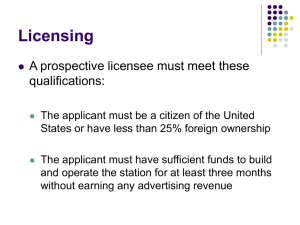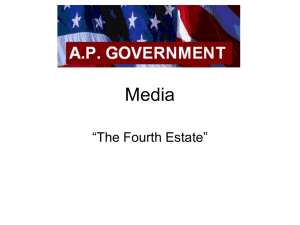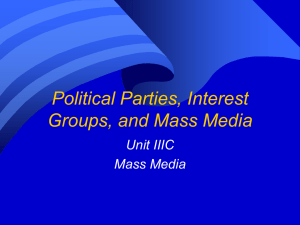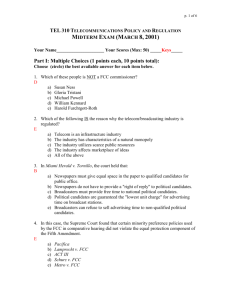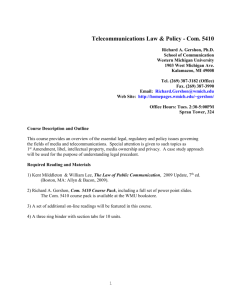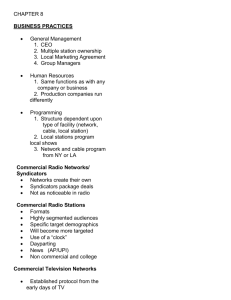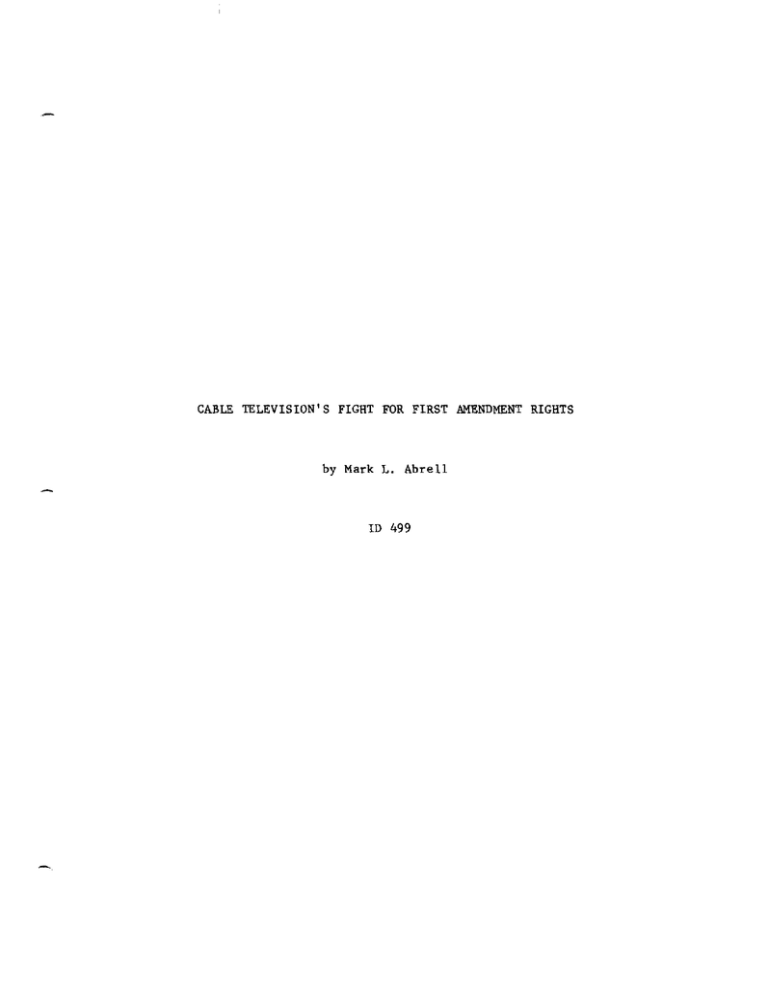
CABLE TELEVISION'S FIGHT FOR FIRST AMENDMENT RIGHTS
by Mark L. Abrell
ill ~9
I)'"
. A!: '1
Throughout history the governmental units of civilized societies have
engaged in some form of regulation regarding the free expression of ideas.
Originally, actual speaking and printed or written literature received the
scrutiny of this regulation.
With the advent of other forms of communication,
such as radio and television, this regulation was expanded to include these new
methods of expression.
In this country, the right to freely express ideas is enumerated in the
First Amendment of the Constitution.
However, the judicial branch, in the form
of the Supreme Court's jud ic ial review powers, has determined that this right is
not absolute.
Currently, only public expressions which fall under the
definition of obscene, as expounded by the high court in Miller v. California,
93 S.Ct. 2607 (1973), can be prohibited at all times.
In Miller, the Court created a carefully constructed test for establ ishing
the boundaries within regulation of expression was permissable.
The Court found
that:
The basic guidelines for the trier of fact must be: (a) whether
"the average person, applying contemporary community standards" would
find that the work, taken as a whole, appeals to the prurient interest ..• (b) whether the work depicts or describes, in a patently offensive way, sexual conduct specifically defined by the applicable state
law; and (c) whether the work, taken as a whole, lacks serious literary, artistic, political, or scientific value. 93 S.Ct. at 2614 (citat ions omit ted).
The Miller standard is the result of years of dealing with the problem of regulation of expression.
It provides a national standard, but through the contemp-
orary community standards provision it provides the flexibility to accommodate
the differing norms of specific communities.
It also has the virtue of almost
universal application to all forms of communication.
These qualities will
probably let it stand the test of time.
Aside from expressions falling under the definition of obscene and a few
others under special circumstances, such as yelling "Fire!" in a crowded
theater, all other expressions are permitted in some form or at some times or
under certain circumstances.
There are, however, certain types of communication
which, because of their special characteristics, are believed to warrant more
limited First Amendment protection.
Radio and television are the primary
focuses of this special consideration.
One manifestation of this special treat-
ment is the Federal Communications Commission which serves as a watchdog for
prohibiting expressions from being broadcast over radio and television which
fall under the protection of the First Amendment under any other medium of
expression.
This paper will focus on the challenges made against the government's
authority at the federal, state, and local levels to prohibit otherwise protected forms of expression from being expressed through the electronic media.
In addition, it will try to show that the advent of new technology in the television industry, i.e. cable and pay systems, should finally enable these higher
forms of electronic media to break the bonds of regulation currently restricting
radio and airwave television.
The first significant challenge to the Federal Communications Commission's
authority to regulate the contents of a radio broadcast was the case of Pacifica
Foundation v. FCC, 556 F.2d 9(D.C. Cir. 1977), rev'd, 98 S.Ct. 3026, (1978).
This case, known as "The Seven Dirty Words" case, established the FCC's authority to prohibit any broadcast which contained any of seven words which it described as indecent.
It also set precedence for the FCC to expand these limits
on broadcast freedom to the television industry.
The events which led to the ajudication of this case are as follows.
On
October 30, 1973, in the early afternoon, WBAI radio station of the New York
2
City area broadcast a monologue entitled "Filthy words" by comedian George Carlin.
A warning was issued prior to the broadcast cautioning listeners to the
possible offensive nature of the monologue.
The broadcast was heard by a father
and his young son while driving in the New York City area. The father lodged a
complaint with the FCC, the only complaint recived by the FCC concerning the
broadcast, in which he referred to the monologue as "garbage" which was unsuitable to be aired during a time when children were obviously part of the listening audience.
The FCC informed the radio station licensee, Pacifica Foundation,
of the complaint and asked for a response. 1
In response, Pacifica explained the context in which the broadcast was aired.
They asserted that it was part of an analysis of the use of language in our
society.
In particular, the monologue was uan incisive satirical view of the
subject under discussion. II
In February of 1975, the FCC issued a Declaratory Order 2
which was meant
to clarify the standards it used to determine if a broadcast was indecent under
the Criminal Code.
The section referred to is as follows:
Whoever utters any obscene, indecent, or profane language by means
of radio communication shall be fined not more than $10,000 or imprisoned not more than two years, or both. June 25, 1948, 62 Stat. 769. 3
The FCC Order was meant to notify broadcasters of the circumstances in which the
FCC would determine the indecent provision of the criminal code to be violated.
Those circumstances include the broadcast of language which is patently offensive by contemporary community standards at times of day when there is a reasonable risk of children being in the audience. 4
The FCC has the authority to
grant broadcasters their licenses and revoke them for such a violation.
While
the FCC did not impose any of the available civil sanctions, it did place a letter of violation in the licensee's renewal file.
3
In response, Pacifica sought
review of the order in the District of Columbia Circuit Courts of Appeals, thus
challenging the FCC's authority to enforce the indecency provision of the Criminal Code.
Pacifica asserted that the order violated the no-censorship clause of the
Communications ActS and the rights to freedom of expression guaranteed by the
First Amendment.
It contended that the criminal code did not give the FCC the
authority to prohibit non-obscene material from being broadcast just because it
is "offensive".
In addition, Pacifica argued that the Supreme Court's earlier
dec is ions made it nearly imposs ible to establ ish a constitutionally acceptable
definition for I'indecent" which would not be synonomous with l1 obscene".6
Thus
Pacifica claimed that the FCC's definition of "indecent" which left out an
"appeal to the prurient interest" in addition to failing to consider the
-
material's "literary, artistic, political, or social value," was overbroad and
therefore unconstitutional.
Pacifica also argued that just because the broadcast medium is said to be
more intrusive than other media, it is not so un1que that it should be subjected
to undue limits on basic First Amendment principles.
They also challenged the
contention that parents have less ability to supervise their children with
regard to radio and television than with books and movies.
Pacifica claimed
that the FCC order " . .. would effectively empower a majority ..• to silence
dissidents simply as a matter of personal predilections ."7
Pac ifica' s next argument referred to the effect such language had on
listeners.
They asserted that the FCC's reason for wishing to prohibit such
language was not because they believed it had a harmful effect on listeners (as
is suggested with the broadcast of material containing violence), but merely
because it received complaints from a minority of listeners.
4
Pacifica also
claimed that the list of "forbidden words" could easily begin to expand to
include a number of words and ideas which represent controversial views on any
range of subjects which are offensive enough to some listeners as to warrant
complaints.
Indeed, though the FCC order seemed to allow for the broadcast of
such words and ideas at times which would avoid children in the listening
audience, two of its commissioners would have banned these words from the
airwaves completely.
Pac ifica attacked the FCC's definit ion of indecent as being so broad as to
include certain words even when the context in which they are used eliminates
any sexual or ex,cretory connotations.
In addition, Pacifica contended that the
definition is impractical since uncensored public news events as well as great
literary works could fall under the definition and therefore be prohibited from
broadcast.
Used in this context, Pacifica claimed, the order would discriminate
against minorit ies and subcultures in our Soc iety whose views of acceptable
language and ideas were outside the conventional mainstream.
The FCC's main argument for the order was that under its responsibility "to
promote the larger and more effective use of radio in the public interest" as
provided for in the Counnunications Act, it was responsible for keeping traditionally adult language from reaching the ears of children.
responsibility upon itself the FCC made several assumptions.
In taking this
It assumed that by
stopping this language at its source it was serving the publ ic interest.
It
assumed that parents don't wish their children to hear such language regardless
of the context in which it is used.
It assumed that parents don't have the
ability to prevent their children from listening to radio or television.
ly,
Last-
it assumed that the public interest served by prohibiting this language
outweighs the First Amendment rights of the broadcaster and the adult listeners
5
rights to have programming made available to them which is not just suitable for
children.
Pacifica ch"llenged all of these assumptions.
In addition, it stated its
concern that if the FCC is allowed to protect children from offensive language
the door is left open to them to try to protect children from offensive political and religious beliefs.
Ultimately, if the FCC could protect children under
certain circumstances then it became possible for them to attempt to protect
anyone in the name of the public interest.
The FCC, in addition to arguing the validity of its assumptions, contended
that the physical characteristics associated with radio communication were so
different from other media as to warrant special First Amendment considerations.
The FCC attempted to support this contention stating that "the passive act of
listening to the radio is different, practically, socially, and physically from
obtaining literature or gaining admission to a movie theatre."
In addition to
the fact that children can be excluded from theatres and bookstores, the FCC
asserted that parents can regulate their children's access to movies and litera-
ture easily, while young radio and television audiences are usually devoid of
parental supervision.
contention.
They provided no scientific or statistical base for this
At trial they urged the court "not to allow the tastes of a small
minority of radio listeners to displace the judgment of society at large that
there be restrictions- narrow, specific, and focused on a particular objective
-to protest the sensibilities of the great majority about what language may be
shared with children."
In light of the fact that only one complaint was re-
ceived concerning the broadcast the FCC's statement would seem more suitable
coming from Pacifica.
The Court of Appeals reversed the FCC's order by a two-to-one marg 10.
6
The
majority opinion stated that; "Without deciding the perplexing question of
whether the FCC, because of the unique characteristics of radio and television,
may prohibit non-obscene speech or speech that would otherwise be constitutionally protected, we find that the challenged ruling is overbroad and carries the
FCC beyond the protection of the public interest into the forbidden realm of
censorsh ip. 118
The court went on to crit ic ize the amb iguity of the order,
agree- ing with Pacifica that under its original construction it would
effectively prohibit uncensored versions of Shakespearian plays and portions of
the Bible.
The court went on to criticize the order because of its failure to
even attempt to define children.
Does a nineteen-year-old require the same
protection as a seven-year-old?
The court rejec ted the FCC's assumpt ion that without such regulat ion the
airwaves would become overburden with filth.
Instead it felt that the FCC, as
it had done in previous cases, should leave decisions of community interests and
taste to the licensee.
The court explained that: "To whatever extent we err, or
the Connniss ion errs in balanc ing its dut ies, it must be in favor of preserving
the values of free expression and freedom from governmental interference in
matters of taste." 9
With regard to one of the FCC's main contentions, that parents are unable
to supervise their children's access to radio and television, the court, in addition to challenging this assumption, went beyond this argument and questioned
whether most parents would consider the mention of the "forbidden words ll under
all circumstances as unsuitable for their children.
The court agreed with
Pac ifica that, if the FCC is allowed to act in the parents behalf with respect
to offensive language it could do the same with regard to any controversial
topic.
In addition, the court recognized that First Amendment rights are also
7
extended to children.
Thus, while it avoided the actual question of whether the
FCC had the authority to regulate non-obscene language it did recognize and assert that the problems created by such an attempt to control the airwaves were
greater than those perceived to occur by letting such materials have the benefit
of the doubt.
In a narrow five-to-four decision the Supreme court reversed the Circuit
court decision and found for the FCC.lO
The majority narrowed the effect of
its judgment considerably in this case.
Pac ifica had raised issues concerning
the effect which the FCC's order would have on other types of broadcasts.
Yet,
the Court refused to consider this particular case in any hypothetical manner.
Thus, it underlined the fact that the order in question was only being
considered for the specific circumstances for which it was issued, the broadcast
of the Carlin monologue.
As to Pacifica's claim that section 326 of the Communications Act,ll
the section forbidding censorship, limits the FCC's authority to prohibit the
content of a broadcast, the Court disagreed, citing numurous previous cases
which held that censorship was editing a proposed broadcast in advance, and that
the censorship ban did not limit the FCC's power to review the content of
completed broadcasts. l2
The Court, in answering the question concerning the
effect of this power being self-censorship, cited the FCC's indication that it
would not impose sanctions without warning in cases in which the applicability
of the law was unclear. l3
Thus indicating that broadcasters, as with the
Pac ifica case, would receive one warning when they started using indecent
language over the air.
The next argument which the Court dispelled was Pacifica's contention that
"indecent", as provided for by the Court in Hamling v. United States, 94 S. ct.
8
2887, (1974) could not be construed to be anything but synonomous with the
court's definition of "obscene" as provided in Miller.
The Court stated that
Pacifica was in err in applying the Court's analysis in Hamling, which only
applied to material which was contained in sealed envelopes, to section 1464 of
the Criminal Code which concerns material which is broadcast over the airwaves.
This indicates the Court's special treatment of the broadcast medium.
The Court
agreed with the FCC's contentions concerning the reasons that broadcasts must be
given special consideration.
Due to the intrusive nature and accessibility to
children which dominate the broadcast medium, the Court found that Congress had
intended that non-obscene material which was indecent, or nonconforming with
accepted standards of morality, was to be prohibited from being broadcast over
the pub 1 ic airwaves.
The Court then went on to back the FCC's definition of "indecent" as it
applied to the factual setting.
The Court indicated that in determining whether
a particular broadcast fell under the term "indecent 11 its content as well as
context must be examined.
In such an examination the Court found that there was
no disagreement between the parties as to the content part of the definition,
Carlin's monologue definitely contained material which was patently offensive.
However, concerning the context part of the definition, the Court found that,
although the monologue as broadcast possibly had serious value, because of its
contents it was not required to be afforded the same First Amendment rights as
unoffensive language.
In So doing the Court found that in such a case the
context in which the material was represented UI..lst be considered. The Court
in examining the context of the broadcast, found that even though there was
prior warn1ng as to its possible offensiveness, because it occurred at a time in
which children were obviouSly part of the listening audience, the monologue
9
-
could not be afforded First Amendment rights.
The Court, after making these
considerations, ruled that, given the unique characteristics of the broadcast
medium in conjunction with the circumstances of the broadcast in question, the
FCC was within it authority to rule this particular broadcast as indecent under
the section 1464 of the Criminal Code.
The significance which this decision holds for the cable television
industry lies in the power which it conveys upon the FCC and the creation of an
additional type of regulable material.
This case effectively empowered the FCC
to review the content of materials aired by broadcasters.
This became possibly
more applicable to cable television after the Supreme Court's decision the
following year in United States v. Midwest Video Corp., 99 S.Ct. 1435, (1979) in
which it found that cable te1ev is ion sys terns are broadcas ters, not common
carriers.
This connection, however,
is unclear because in Midwest the Court was
referring to the FCC's rules which treated cable systems as connnon carriers for
the purpose of forcing them to provide public access channels.
The second part
of the decision is important because it establishes a new class of expression
which is open to regulation if used within the broadcast industry.
Thus, it
reinforced the special First Amendment limitations which the broadcast medium
recel.ves.
The main ques t ion left to be answered is whether the noted narrowness of
the decision includes cable television broadcasters.
The Court itself stated
that its decision did not necessarily include broadcast media other than radio.
In addition, the FCC, in proposing legislation which addressed the problem of
obscenity on cable television, found that as currently construed cable
television does not fall under " radio communication" as used in the Criminal
-
Code. 14
Still, the question of whether the special characteristics of cable
10
televis ion, i. e. that broadcasts are transmit ted through privately owned wires
or cables and that the broadcasts are made specifically to subscribers who pay
for the service, eliminated its applicability to the Court's reasoning for why
broadcasting receives limited First Amendment protection had yet to be answered.
The first attempt to regulate the broadcast of "indecent" material by means
of cable television occurred in the Utah state legislature.
Specifically, a law
had been passed which prohibited cable television systems from broadcasting
"indecent" materials to its subscr ibers.
The pert inent sec t ions of the statute
are as fo llows:
(1) No person, including a franchisee, shall knowingly distribute by wire or cable any pornographic or indecent material to its
subscribers.
(2) For purposes of this section "material" means any visual
display shown on a cable television system, whether or not accompanied by sound, or any sound recording played on a cable television
system.
(4) For purposes of this section l1indecent material" means any
material described in section 76-10-1227.
(5) For purposes of this section "distribute" means to send,
transmit, retransmit, or otherwise pass through a cable television
system. 15
Violation of this law was a class A misdemeanor.
Action against violators of
the law was to be intiated by the attorney general or any county or city
attorney of an interested political subdivision.
The statute was to go into
effect on May 11, 1981.
On May 1, 1981, Home Box Office Inc. (HBO)"
in conjunction with several
other cable television systems, couunenced an action in the U.S. District Court
against the Attorney general of the state of Utah individually and as a
representative of the class of all persons empowered to prosecute violations of
the statute in question, Home Box Office, Inc. v. Wilkinson, 531 F.Supp 986,
(1982).
HBO sought injunctive rel ief against the statute. 16
11
The Court granted a temporary restraining order which by agreement of the
parties would remain in effect until the Court reached a decision concerning the
statute's constitutionality.
of the plaintiffs.
After hearing arguments the Court found in favor
The Court asserted that the statute was unconstitutional on
its face because of overbreadth. 17
The defendants did not appeal.
The Court, in the person of District Judge Jenkins, explained the rationale
for its decision.
When establishing the constitutionality of a state statute
which attempts to regulate the expression of ideas, it is necessary to first
delineate the constitutional bounds of protected and unprotected expression.
Then it must be determined if the statute is, on its face, overbroad and seeks
to go beyond the established boundaries of permissable regulation of unprotected
expression.
If it is determined that the statute is facially overbroad then a
final determination must be made to establish whether a limiting construction
may be placed on it to narrow its effects to within constitutional boundaries.
In addition, the Court may also find that abstention is justified by the likelihood that a state court will make the necessary narrowing of the statute's construction during proceedings initiated at some future time. I8
In the case at hand, the Court determined that the permissable areas of
state regulation of expression are defined in Miller through reference to local
community standards. 19
Through the use of the Miller test regulation of
expression is limited to material which the average person applying contemporary
community standards would find, taken as a whole, appeals to the pruient
interest, and depicts or describes,
in a patently offensive way, sexual conduct
specifically defined by the applicable state law, and whether that material
taken as a whole, lacks serious, literary, artistic, political, or scientific
value.
Therefore, states may only regulate materials which fall under this
12
definition of obscenity.
When the statute at hand is examined,
it is obv ious that its intent is to
regulate materials which go beyond Miller. 20
It attempts to prohibit
materials which fall under the state's definition of "indecent".
The state
defines "indecent material" as follows:
For purposes of this act:
(1) "Description or depictions of illicit sex or sexual immorality
means!
(a) Human genitals in a state of sexual stimulation or arousal;
(b) Act of human masturbation, sexual intercourse, or sodomy; or
(c) Fondling or other erotic touching of human genitals, pubic region,
buttock, or female breast.
(2) "Nude or partially denuded figures" means:
(a) Less than completely and opaquely covered:
(i) Human genitals;
( ii) Pub ic reg ions;
(iii) Buttock; and
(iv) Femal., breast below a point immediately above the top of the
areola; and
(b) Human male genitals in a discernibly turgid state, even if completely covered. 21
Section (2) of the definition includes mere nudity to be indecent.
It has been
established by the Supreme Court in Jenkins v. Georgia, 94 S.Ct. 2750, (1974),
that nudity falls well within the protection provided by the First Amendment.
The Utah statute attempts to regulate material which clearly falls under the
protection of the First Amendment and it does so without the safeguards which
examine the value of the material. 22
fac ially overbroad.
Therefore, the Utah statute is
Counsel for the state attempted to just ify the overbreadth
by relying on the state's interests in children.
However, the court found that
even if this argument were accepted the statute would still be overbroad.
The
statute fails to even mention children and by its terms it applies to materials
reaching homes which have no children.
The Supreme Court made it clear in
Butler v. Michigan, 77 S.Ct. 524, (1957), that material cannnot be prohibited
13
from adults in the name of hypothetical children.
The Court, after making the overbreadth determination, felt that a narrow~ng
construction, given the language of the statute, was improper.
Thus, the
Court felt that the overbreadth was so severe that a narrowing construction
would only serve to change the intent of the statute and limit its terms out of
existence.
Judge Jenkins expressed the opinion that the state's pornography
statute was adequate to encompass all the materials broadcast via cable
television which fell within the permissable boundaries of state regulation.
This decision, while a victory for cable television systems, still failed
to adequately answer if regulation that was properly constructed could
effectively limit broadcasts of "indecent" material through cable television
systems.
While the Court did address the the issue, its primary focus was with
the constuction of the statute.
Since the question was never raised, due to the
inadequacy of the statute's construction, this case did not let the court
express the inherent differences between cable and regular broadcast television
which make it irrunune to the regulation presently placed on regular television.
The Court had the chance to more adequate ly address the effec t that the
special characteristics of cable television had on such attempts at regulation
in a case adjudicated not long after the RBO decision.
This time the Court was
asked to consider the constitutionality of an ordinance passed by the City of
Roy, Utah prohibiting the distribution by cable of any "indecent" material.
In this case, Community Television of Utah Inc. v. Roy City, 555 F.Supp.
1164, (1982), the Roy City Council enacted a city ordinance which prohibited the
transmission, by means of cable television, of any materials which fell under
the definition of "indecent" as defined in the Roy City Ordinance, Title 17
concerning licenses.
The Roy definition reads as follows:
14
(6) "Indecent Material" shall mean material which is a representation or verbal description of:
(a) An erotic human sexual or excretory organ or function; or
(b) Erotic nudity; or
(c) Erotic ultimate sexual acts, normal or perverted, actual or
simulated; or
(d) Erotic masturbation;
which under contemporary community standards is patently offensive.
(7) "Erotic" shall mean tending to arouse sexual feelings or
desires. 23
Several residents of Roy and the aforementioned cable system filed this action
to avoid the enforcement of said ordinance on the grounds that it was
unconstitutionally overbroad.
The Court found in favor of the plaintiffs and
declared the ordinance overbroad. 24
The pert inent issues raised in th is case re late to the differences between
television which is received over the public airwaves and television which is
transmitted by means of privately owned cables or wires.
The defendants relied
heavily upon the Pac ifica case and attempted to make analogies between the power
of the city to regulate with that of the F.C.C., the widespread use of cable
service within the conununity to the pervasive nature of regular television, and
the duty of the city to improve the morals of its citizens to the protection of
the "public interest."
The Court, in rejecting these analogies, provided a list
of the important differences between cable and broadcast television. 25
Cable
Broadcast
1.
User needs to subscribe.
User need not subscribe.
2.
User holds power to cancel
sUbscriptions.
User holds no power to cancel.
May complain to FCC, station,
network or sponser.
3.
Limited advert is ing.
Extensive advertising.
4.
Transmittal through wires.
Transmittal through airwaves.
5.
User receives signal on
private cable.
User appropriates signal from
pub I ic airwaves.
15
6.
User pays a fee.
User does not pay a fee.
7.
User receives preview of
coming attractions.
User receives daily and weekly
listing in public literature.
8.
Distributor or distributee
may add services and expanded
spectrum of channels.
Neither distributor nor distributee may add services or
channels.
9.
Wires are privately owned.
Airwaves are not privately owned but are publicly controlled.
These differences listed above make analogies with the Pacifica case nearly
impossible.
Pacifica dealt with "broadcasting," even the F.C.C. no longer holds
cable transmission to be broadcasting. 26
Neither the Court nor the city of
Roy use the Supreme Court's holding in Midwest,27 apparently because its
application would seem to be rather tenuous.
In the Pacifica case, the Supreme
Court emphasized the narrowness of its decision saying that the "decision rested
,-
ent irely on a nuisance rat ionale under which context is all-important. 1128
The Roy City ordinance makes no mention of the context in which the materials
are presented in its definition of indecent.
Therefore, even without the
aforementioned differences between cable and broadcast television, the city of
Roy's reliance on the Pacifica case is unjustified.
The city, in trying to apply the concept of pervasiveness, contends that
the widespread use of the cable system's services within the community give the
local cable television a pervasive quality.
contention.
The Court disagreed with this
The literal meaning of pervasiveness is ever-present .29
While
broadcasting, which is accomplished by transmitting into the air signals which
can be received by anyone, may be construed to have this quality, cable
tranmission, which sends signals to specific people by wire, cannot be.
The only doctrine, so far, that allows a regulating body to go beyond
Miller with regard to the regulation of expression is when the regulating unit
16
-
has a duty to act in the "public interest."30
Using the broadcast industry
as an example Judge Jenkins explained, "[blecause of the limited number of
broad- casters, their use of the pubicly controlled airways and their favored
economic opportunity in using a limited public resource, broadcasters are
charged to act 'in the public interest. '"
Such a responsibility does not exist
for cable television systems merely because they do not use a resource which is
either pubicly controlled or limited, for all practical purposes.
Even if it
could be construed that the cable system had a duty to act "in the public
interest" and that the city of Roy had the authority to act as a watchdog for
the fulfillment of that duty, it seems rather unfair to the cable system that
the ordinance fails to mention any public interest to be served (such as
protecting children from adult materials).
The F.C.C., in the case which Roy
relies, at least implied the protection of children in its Declaratory Order
which prohibited indecent language "when there is a reasonable risk that children may be in the audience."32
Thus, the city of Roy's ordinance fails to
qualify for extended regulatory power under the "public interest" doctrine.
Roy City provides an extensive analysis of the differences between cable
and airwave television.
It highlights the reasons that make the FCC's reasoning
inapplicable to cable television regulation.
in Roy City
The Utah District Court's decision
was reaffirmed less than a year later by a Florida District Court
1n Cruz v. Ferre, 571 F.Supp. 125 (1983).
In Cruz, the circumstances were very similar to the Roy City case.
The
city of Miami had passed an ordinance prohibiting the transmission by cable of
11
indecent material. II The ord inance was to be enforced by the city manager who,
in that capacity, acted as "complainant, jury, judge, and executioner."
-
The
Court found that the ordinance was facially overbroad and unsalvable by any
narrowing of its construction. 33
17
A few differences between Cruz and Roy City make it worth further elaboration.
In Cruz, the city had, in its franchise agreement with Miami Cablevision,
stated that "[ iln accept ing this license, the licensee acknowledges that its
privileges hereunder are subject to the police power of the city ... and the
licensee ... agrees to comp ly with all appl icab le general laws, reso lut ions and
ordinances presently in force or subsequently enacted by the city pursuant to
such power. "34
Thereby, the city attempted to do by contract or license
what it could not normally do by law.
This attempt was subsequently rejected.
The Court also rejected the city's definition of indecent, which, aside
from not making the risk to children a provision, was very similar to the FCC's
definition in Pacifica. 35
Though in leaving out a plausible reason for its
action, i.e. the protection of children, and in failing to take into account the
context of the questionable material, the Miami definition could not hope to
rely so heavily upon Pacifica, which it asserted was the authority on its case.
A small but interesting difference also occurs in this case.
The local
cable system, Miami Cablevision, was not one of the plaintiffs in this case.
Rather, they, because of their perceived contractal obligations to the city,
intervened as a defendant.
the case,
it was den ied.
Though they later filed a motion to withdraw from
Th is is signif icant in that the Court gave stand ing to
a subscriber even when the cable system which would be directly affected by the
ordinance was willing to comply with the regulation.
This would seem to
indicate that a subscriber has a right to receive unregulated materials through
their cable system regardless of whether that cable system is willing to
exercise its rights to freedom of expression.
These cases, HBO, Roy City, and Cruz, all seem to support the view that
cable television is, through its special characteristics, to be afforded full
18
First Amendment considerations.
Yet, these are only District Court decisions.
The Supreme Court has yet to deal directly with the question of cable television
regulation.
It
attempted has
is also worth noting that thus far none of the regulation
beE~n
constructed in such a way, i.e. taking into account the con-
text of the material and the risk of its exposure to children, that would make
Pacifica applicable. 36
The likelihood of this occurring is becoming ever greater.
With the
increase in cable availibility and the new types of entertainment which it may
supply, has come increased attention to the possible progrannning that is fast
becoming available.
Congress has already had a bill introduced by Senator
Dennis DeConcini (D-Ariz.) which would have prohibited questionably protected
materials from appearing on our television sets.
committee.
I t may be reintroduced
However, the bill died in
in the new Congress. 37
There are an increasing number of special interest groups and religious
organizations appearing which are lobbying for such laws on the federal level
and pushing for and helping construct such laws on the state and local levels.
One such group, Morality in Media, is already offering a "model law" to groups,
cities, and state legislatures.
The president of Morality in Media, Reverend
Morton A. Hill S.J., has been urging his audiences at dinners and meetings,
designed to make the public aware that there is a "porn-problem" on cable
television, to write letters to President Reagan urging him to instruct the
justice department to enforce existing anti-pornography laws.
Such is the fight
for control of the media. 38
Even though the courts have so far made it clear in the aforement ioned
cases that local governmental entities have no business trying to regulate the
-
content of cable transmissions, there is a hidden aspect which may end up having
19
the same effect on the cable systems as if the regulation attempts had not been
overturned.
This hidden aspect is probably why Miami Cablevision was on the
city's side of Cruz.
It probably is responsible for the fact that
the actual
number of occurrences of questionable material being transmittted through cable
systems is still very small.
This hidden aspect is called refranchising.
Since
the cable systems must inevitably return to those who would regulate their
transmiss ions to beg and plead for their livel ihoods to be renewed, it does not
seem surprising that not much in the way of controversial programming has
appeared on cable. 39
So while the courts may be saying that cab Ie sys terns can transmit anyth ing,
barring material prohibited by Miller, the cities can simply sit back and wait
until it COmes time for licenses to be renewed.
for running scared?
franchise.
Who can blame the cable systems
There is still money to be made if they can just keep their
This does not, however, seem like a very good atmosphere to exerc ise
one's First Amendment rights to freedom of speech.
No matter what the courts
say, until their authority to grant and regrant franchises is taken away, local
governments will still exercise an invisible hand in the cable programming
process.
Yet, until that time comes the cable industry may at least take vic-
tories in the courts, as steps in the right direction.
The Supreme Court will inevitably get its chance to answer the question of
whether cable television and the content of its programming are subject to any
regulation beyond Miller.
The only questions which must be made clear are
whether the fact that cable transmissions are paid for by the subscriber qualifies them as being invited into the subscribers home.
And most importantly the
court must answer as to whether cable systems have a duty to act in the public
interest.
These are the main differences which must be resolved if Pacifica is
20
to become applicable to cable television.
I believe the Court will determine
that cable television's special characteristics make it a private business with
no special duty to act in the public interest and therefore make Pacifica
inapplicable.
In this way I believe the court will show support for Judge
Jenkin's analysis of the importance of our First Amendment rights to freedom of
expression.
As he stated in Roy City, referring to the reason questionable
material must be allowed to exist, nlwl e tolerate the ideas of others and the
communications which frame those ideas because we want others to tolerate us,
our ideas, our points or view.
A monolithic social structure which is tolerant
of nothing but approved ideas or points of view is too much akin to the horror
of the German Reich."
It is imperative that the dissent receive a voice.
The
freedom to disagree with the government and the mainstream ideas of our society
is one of the greatest virtues of this country.
Yet, if those who disagree are
unable to attain a platform for their ideas, then the freedom to disagree and be
different becomes very hollow.
Therefore, it would be a great wrong to let the
government, in one form or another, gain control of yet another medium of communication and further shut out the dissenting voices and controversial ideas as
it has already done through the FCC with radio and airwave television.
Cable
television offers a practically unlimited amount of space to express any and all
ideas and viewpoints on an unlimited number of subjects, but unless it is free
from the control of government it will become flooded with and limited to the
homogenized appeals to the mainstream of our soc iety which currently plague
convent iona! televis ion.
21
-
NOTES
1 Pacifica Foundation, 56 F.C.C. 2d 94 (1975).
2 Ibid.
3 18 U.S.C. §1464.
4 Pacifica Foundation, 56 F.C.C. 2d 94 (1975).
5 47 U.S.C. §326.
6 Hamling v. United States, 94 S.Ct. 2887, (1974).
7 Pacifica Foundation v. FCC, 556 F.2d 8 (D.C. Cir. 1977).
8 Id., 556 F.2d at 9, 10.
9 Id., 556F.2d at 18.
10 Pacifica Foundation v. FCC, 98 S.Ct. 3026, (1978).
11 47 U.S.C. §326.
12 Pac ifica Foundation v. FCC, 98 S.Ct. at 3034.
13 Pac ifica Foundation v. FCC, 556 F.2d at 7.
14 18 U.S.C. §l464.
15 Utah Code Ann. § 76-10-1229 (Supp. 1981) •
16 Ibid.
17 Home Box Office, Inc. v. Wilkinson, 531 F.Supp. 986 (1982).
18 Id., 531 F.Supp. at 991-992.
19 Miller v. California, 93 S.Ct. 2607, (1973).
20 Home Box Office, Inc. v. Wilkinson, 531 F.Supp. at 999.
21 Utah Code Ann. § 76-10-1227.
22 Miller v. California, 93 S.Ct. at 2622-2627.
23 Roy City Ordinance, § 17-3-6, (1982).
24 Community Television, Inc. v. Roy City, 555 F.Supp. 1164 (1982).
NOTES cont'd
25 Id., 555 F.Supp. at 1167.
26 See, Order of December 7, 1977, 67 F.C.C.2d 252 (1977).
27 United States v. Midwest Video Corp., 99 S.Ct. 1435, (1979).
28 Pacifica Foundation v. FCC, 98 S.Ct. at 3034.
29 See, Webster's New International Dictionary 183 (2d ed. 1955).
30 Pacifica Foundation v. FCC, 98 S.Ct. at 3040.
31 Community Television, Inc. v. Roy City, 555 F.Supp. at 1169.
32 Pacifica Foundation, 56 F.C.C.2d 94 (1975).
33 Cruz v. Ferre, 571 F.Supp. 125 (1983).
34 City of Miami Ordinance No. 9332, §203(a), (1981).
35 Pacifica Foundation v. FCC, 98 S.Ct. at 3031.
36 Ibid.
37 "Making federal case out of cab le porn," Broadcast ing, Feb. 21, 1983.
38 Ibid.
39 "Cable and the quest for First Amendment freedom," Schildhause, Sol;
Broadcasting, Sep. 26, 1983.
BIBLIOGRAPHY
Hamburg, Morton r., All About Cable, Law Journal Seminars-Press, New York,
New York, 1981.
Schildhause, Sol, "Cable and the quest for First Amendment freedom," Broadcasting, Sep. 26, 1983, p.22.
"Making federal case out of cable porn," Broadcasting, Feb. 21, 1983, pp.73-74.
"Should government regulate cable?," Broadcasting, Oct. 31, 1983, p.7l.
"Tricky quest ions abound over cable I s First Amendment rights," Broadcast ing,
Dec. 19, 1983, pp.56-57.
"Wirth's cable bill comes under fire," Broadcasting, Nov. 7, 1983, pp.37-38.
Butler v. Michigan, 77 S.Ct. 524, (1957).
Community Television of Utah, Inc. v. Roy City, 555 F.Supp. 1164, (1982).
Cruz v. Ferre, 571 F.Supp. 125, (1983).
Hamling v. United States, 94 S.Ct. 2887, (1974).
Home Box Office, Inc. v. Wilkinson, 531 F.Supp. 986, (1982).
Jenkins v. Georgia, 94 S.Ct. 2750, (1974).
Miller v. California, 93 S.Ct. 2607, (1973).
Pacifica Foundation v. FCC, 556 F.2d 9 (D.C. Cir. 1977), rev'd, 98 S.Ct.
3026, (1978).
United States v. Midwest Video Corp., 99 S.Ct. 1435, (1979).



